Effect of level of effluent from plastic biodigesters loaded with pig manure
on the growth of mulberry (Morus alba) trees
Chiv Phiny, Khieu Borin and Chhay Ty
Center for Livestock and Agriculture Development, UTA-Cambodia
POB 2423, Phnom Penh 3, Cambodia
Phiny_kh@yahoo.com
Abstract
An agronomy trial to evaluate the effect of level of effluent from plastic biodigesters loaded with pig manure on the growth of mulberry (Morus alba) trees was conducted for one year (25 August 2004 to 25 August 2005) during both the dry and rainy seasons in the ecological farm of CelAgrid-UTA Cambodia, which is located in Kandal village, near to Phnom Penh, the capital of Cambodia. The trial included six treatments with four replications, divided into 4 blocks according to Complete Randomized Block Design. The effluent application levels were 0, 100, 250, 400, 550 and 700kg N / ha / year. Effluent was applied every 7days. Mulberry foliage was harvested (cutting height 60 cm above ground level) after 3 months and again at 2 month intervals. The foliage was separated into stem and leaf + petiole and analyzed for dry matter (DM) and nitrogen (N).
Dry matter biomass yield of mulberry foliage, and crude protein content of leaves increased linearly with the amount of effluent N applied.
Key words: Biodigester, effluent,
manure, mulberry, biomass, fertilizer
Introduction
Mulberry is a traditional feed for silk worms and is
reported to have a high edible biomass yield of 12 to 15 tonnes DM/ha/year, with
a cutting interval of about 9 to10 weeks. The leaves have a high protein content
(18 to 25% CP in DM) and high in vivo
DM digestibility (75 to 85%). It thus has a high potential as a protein-rich
forage supplement for ruminant production (Nguyen Xuan Ba et al. 2004). Mulberry
plants grow very well in the rainy season, especially when fertilizer is
applied. However, fertilizer use for mulberry production is very low in Cambodia
because of the high cost of chemical fertilizer. Biodigester effluent is one
option to be investigated in order to develop better crop growing practices. The
advantages of passing manure through a biodigester are many and include gas
production for cooking, improved health through elimination of pathogens and no
loss of plant nutrients in the process (Bui Xuan An et al 1997).
A study was therefore carried out to compare the effect of different levels of effluent from a plastic biodigester charged with pig manure on biomass yield and composition of mulberry foliage. The objective of the trial was to determine the optimum level of effluent from a low-cost plastic biodigester with respect to the yield and composition of mulberry foliage.
Materials and methods
Location
The research was carried out at the ecological farm
of CelAgrid-UTA Cambodia, located in Kandal village, Ro Lous commune, Khandal
Steung district, Khandal Province. The center is about 25 km from Phnom Penh
City. Previously the field had been used for monoculture rice production.
Experimental period
Soil and plot preparation, and preparation and transplanting of the mulberry seedlings was carried out from March to July 2004. The agronomy trial lasted from 25 August 2004 to 25 August 2005.
Plot size
Twenty four plots were prepared with a total area of 918 m2. Each plot had an area of 38.25 m2 (8.5m x 4.5m) and there were153 seedlings per plot (see Photo 1 and 2).
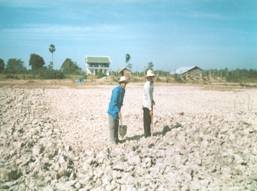 |
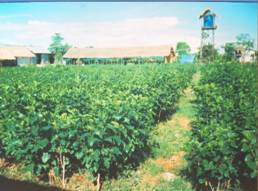 |
|
|
Photo 1: Plot preparation before transplantation |
Photo 2: Mulberry trees 2 months after transplanting |
Design and treatments
Six (6) levels of effluent (0, 100, 250, 400, 550 and 700 kg of N/ha per year) were used in a production function design, with application rates made according the N content of the effluent from a low cost plastic biodigester linked to a pig pen. The 6 treatments had 4 replications divided into 4 blocks according to a Complete Randomized Block Design (Table 1). Planting distances of the cuttings were 60 cm and 50 cm between plants and rows, respectively.
The treatments consisted of six levels of fertilizer application with effluent from two low cost plastic biodigesters charged with pig manure:
-
EFF0 : No application of effluent
-
EFF100 : 100kg N of effluent applied per hectare
-
EFF250 : 250kg N of effluent applied per hectare
-
EFF400 : 400kg N of effluent applied per hectare
-
EFF550 : 550kg N of effluent applied per hectare
-
EFF700 : 700kg N of effluent applied per hectare
|
Table 1: Layout of experimental mulberry plots |
||||||
|
Block |
|
Treatments |
|
|
||
|
I |
EFF550 |
EFF400 |
EFF100 |
EFF0 |
EFF700 |
EFF250 |
|
II |
EFF400 |
EFF100 |
EFF0 |
EFF700 |
EFF250 |
EFF550 |
|
III |
EFF100 |
EFF0 |
EFF700 |
EFF250 |
EFF550 |
EFF400 |
|
IV |
EFF0 |
EFF700 |
EFF250 |
EFF550 |
EFF400 |
EFF100 |
The biodigesters
Two plastic biodigesters were constructed. The
diameter of the plastic polyethylene tube was 100 cm and the length 10 m. Each
biodigester was linked with pig pens. The total volume of each biodigester was 7
860 litres with the liquid phase occupying 5 890 litres. Each biodigester
discharged into an effluent tank of approximately 1 000 litres capacity.
Pig manure was put into the biodigesters through washing the pens 2 times per
day.
Fertilizer application
During the dry season (December through May) the plots were irrigated by water pumped from underground sources . Effluent was pumped from the effluent tank and stored in 6 earthenware jars (about 500 litres capacity) close to the mulberry plots (Photo 3, 4) and was applied at weekly intervals in amounts adjusted according to the results of the N analysis .
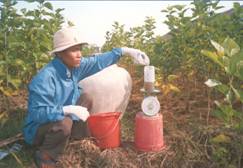 |
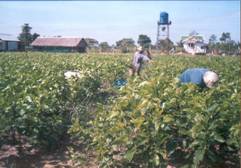 |
|
|
Photo 3: Storage container for the effluent |
Photo 4: Applying the effluent |
Harvesting
The mulberry plants were harvested by cutting the entire plant at 60 cm above soil level. The first time of harvesting was 4 months after planting, and subsequently at 2 month intervals. During harvesting, the biomass of mulberry foliage of each treatment was weighed and then separated into leaves and stems. The harvesting period lasted about 3 days.
Data collection
Samples of soil were taken from each plot before planting and after each harvest. Samples of effluent were analyzed for N before application to the mulberry plots. Before determining biomass yield, the proportions of leaves, stems and petioles were measured and samples from all treatments taken for analysis.
Measurements
The entire harvested plant (stems, petioles and leaves) was weighed after each harvest. DM was determined by using a microwave oven (Undersander et al 1993). The ratio of leaf and petiole to stem was calculated and approximately 100g of each plant fraction (stem, leaf and petiole) for each treatment was retained for analysis. Samples from replicates were analyzed for N and Ash (AOAC 1990) and also for water soluble dry matter (WVDM) and water soluble nitrogen (WVN). In each treatment and replicate plot a soil sample of 0.5 kg was taken at approximately 30cm depth and was kept for analysis of pH, N, DM and Ash.
Statistical analysis
The data were analyzed using the General Linear Model option of Minitab (version 13.31) ANOVA software. The sources of variation were level of effluent, harvest (1st, 2nd, 3rd, 4th and 5th) and error.
Results and discussion
Composition of effluent
Data on the composition of the biodigester effluent (Table 2) are similar to those reported by Bui Phan Thu Hang (2003).
|
Table 2: Composition of biodigester effluent from pig manure |
|
|
Parameter |
Mean value |
|
pH |
6.59 |
|
DM, % |
3.52 |
|
N, mg/litre |
430 |
|
NH3-N, mg/litre |
392 |
Effect of effluent on biomass yield and composition
of mulberry leaves
Mean values for biomass yields of mulberry foliage in fresh and dry matter for individual treatments are given in Table 3 and 4. Main effects are compared in Table 5 and 6 and illustrated graphically in Figures 1, 2, 3 and 4.
|
Table 3: Effect of different levels of effluent application on the biomass yield of fresh mulberry foliage |
|
|||||||
|
Treatment |
0 |
100 |
250 |
400 |
550 |
700 |
SE |
P |
|
kg/plot |
|
|
|
|
|
|
|
|
|
Whole plant |
9.67 |
16.4 |
18.4 |
22.7 |
25.9 |
29.3 |
2.84 |
0.000 |
|
Leaf |
6.36 |
10.1 |
11.9 |
14.4 |
16.5 |
18.6 |
1.95 |
0.000 |
|
Stem |
3.31 |
6.32 |
6.58 |
8.28 |
9.38 |
10.8 |
1.10 |
0.002 |
|
kg/m2 |
|
|
|
|
|
|
|
|
|
Whole plant |
0.25 |
0.43 |
0.48 |
0.59 |
0.68 |
0.77 |
0.07 |
0.000 |
|
Leaf |
0.17 |
0.26 |
0.31 |
0.38 |
0.43 |
0.49 |
0.05 |
0.000 |
|
Stem |
0.09 |
0.17 |
0.17 |
0.22 |
0.25 |
0.28 |
0.03 |
0.002 |
|
Tonnes/ha |
|
|
|
|
|
|
|
|
|
Whole plant |
2.53 |
4.29 |
4.82 |
5.93 |
6.76 |
7.67 |
0.74 |
0.000 |
|
Leaf |
1.66 |
2.64 |
3.10 |
3.76 |
4.31 |
4.86 |
0.51 |
0.000 |
|
Stem |
0.87 |
1.65 |
1.72 |
2.17 |
2.45 |
2.81 |
0.29 |
0.002 |
|
Table 4: Effect of level of effluent on biomass yield (DM) of mulberry foliage |
||||||||
|
Treatment |
0 |
100 |
250 |
400 |
550 |
700 |
SE |
P |
|
kg/plot |
|
|
|
|
|
|
|
|
|
Whole plant |
3.6 |
5.8 |
6.3 |
7.7 |
8.5 |
9.0 |
0.86 |
0.000 |
|
Leaf |
2.0 |
2.9 |
3.5 |
4.2 |
4.5 |
4.9 |
0.48 |
0.000 |
|
Stem |
1.4 |
2.7 |
2.7 |
3.2 |
3.6 |
3.8 |
0.43 |
0.002 |
|
kg/m2 |
|
|
|
|
|
|
|
|
|
Whole plant |
0.09 |
0.15 |
0.17 |
0.20 |
0.22 |
0.23 |
0.02 |
0.000 |
|
Leaf |
0.05 |
0.08 |
0.09 |
0.11 |
0.12 |
0.13 |
0.01 |
0.000 |
|
Stem |
0.04 |
0.07 |
0.07 |
0.08 |
0.09 |
0.10 |
0.01 |
0.002 |
|
Tonnes/ha |
|
|
|
|
|
|
|
|
|
Whole plant |
0.89 |
1.47 |
1.60 |
1.93 |
2.11 |
2.27 |
0.21 |
0.000 |
|
Leaf |
0.51 |
0.77 |
0.90 |
1.09 |
1.17 |
1.27 |
0.12 |
0.000 |
|
Stem |
0.38 |
0.70 |
0.70 |
0.84 |
0.94 |
1.00 |
0.11 |
0.002 |
Effects of biodigester effluent on the chemical composition of mulberry foliage are shown in Table 6.
|
Table 5: Effect of level of effluent on biomass yield (DM) of mulberry foliage |
||||||||
|
Treatment |
0 |
100 |
250 |
400 |
550 |
700 |
SE |
P |
|
kg/plot |
|
|
|
|
|
|
|
|
|
Whole plant |
3.6 |
5.8 |
6.3 |
7.7 |
8.5 |
9.0 |
0.86 |
0.000 |
|
Leaf |
2.0 |
2.9 |
3.5 |
4.2 |
4.5 |
4.9 |
0.48 |
0.000 |
|
Stem |
1.4 |
2.7 |
2.7 |
3.2 |
3.6 |
3.8 |
0.43 |
0.002 |
|
kg/m2 |
|
|
|
|
|
|
|
|
|
Whole plant |
0.09 |
0.15 |
0.17 |
0.20 |
0.22 |
0.23 |
0.02 |
0.000 |
|
Leaf |
0.05 |
0.08 |
0.09 |
0.11 |
0.12 |
0.13 |
0.01 |
0.000 |
|
Stem |
0.04 |
0.07 |
0.07 |
0.08 |
0.09 |
0.10 |
0.01 |
0.002 |
|
Tonnes/ha |
|
|
|
|
|
|
|
|
|
Whole plant |
0.89 |
1.47 |
1.60 |
1.93 |
2.11 |
2.27 |
0.21 |
0.000 |
|
Leaf |
0.51 |
0.77 |
0.90 |
1.09 |
1.17 |
1.27 |
0.12 |
0.000 |
|
Stem |
0.38 |
0.70 |
0.70 |
0.84 |
0.94 |
1.00 |
0.11 |
0.002 |

Figure 1: Biomass yield response to fertilizer effluent
Crude protein increased in the leaves, but was unchanged in the stems, in response to effluent N application (Table 6 and Figure 2). Conversely DM content increased in stems but was unchanged in leaves in response to effluent N (Figure 3).
|
Table 6: Effect of level of effluent on the composition of mulberry foliage |
||||||||
|
|
0 |
100 |
250 |
400 |
550 |
700 |
SE |
Prob |
|
DM,% |
|
|
|
|
|
|
|
|
|
Whole plant |
37.1 |
35.7 |
34.5 |
34.8 |
32.8 |
31.1 |
0.53 |
0.000 |
|
Leaf |
30.6 |
29.4 |
29.1 |
30.1 |
27.4 |
27.3 |
0.48 |
0.000 |
|
Stem |
43.5 |
42.0 |
39.9 |
39.5 |
38.2 |
34.9 |
1.00 |
0.000 |
|
Crude protein, % in DM |
||||||||
|
Whole plant |
10.8 |
12.1 |
11.9 |
12.4 |
11.6 |
12.7 |
0.57 |
0.216 |
|
Leaf |
16.5 |
18.7 |
18.2 |
20.1 |
18.9 |
20.9 |
0.75 |
0.002 |
|
Stem |
7.50 |
8.73 |
9.69 |
8.34 |
7.81 |
8.65 |
0.58 |
0.127 |
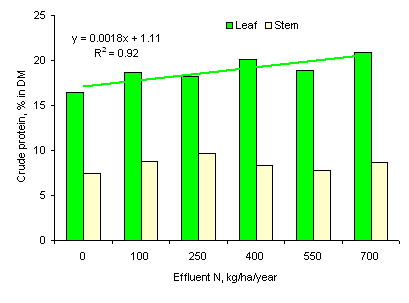 |
 |
|
|
Figure 2: Trends in crude protein of leaves and stems in response to fertilizer effluent |
Figure 3: Trends in DM of leaves and stems in response to fertilizer effluent |
The trends for total biomass yield are similar to those of Ramos et al (Web page; no date) who applied swine lagoon effluent to mulberry plants, although the actual yields were much lower inour study. Biodigester effluent from pig manure thus has been shown to be an effective nutrient source and can replace commercial fertilizer. Goat manure applied to mulberry in Costa Rica increased DM yield linearly (Benavides et al 1994) and yield was higher when N was applied in the form of manure in comparison with fertilizer (Takahashi and Kronka 1968).
The crude protein contents of mulberry leaves was significantly different among treatments (P<0.01), and ranged from16.5 % (EFF0) to 20.9 % (EFF700) of DM, values that are higher than those (15.0 - 15.3 %CP, DM basis) reported by Singh and Makar (2000). The positive effect of fertilizer level on the CP content in mulberry leaves was confirmed by Rodríguez et al (1994).
Conclusions
-
Dry matter biomass yield of mulberry foliage, and crude protein content of leaves increased linearly with the amount of effluent N applied
Acknowledgments
The authors would like to express their gratitude to
the personnel of the Center for Livestock and Agriculture Development,
UTA-Cambodia, for help with the experiment. Thanks for financial support by the
Cambodian Agricultural Research Fund (CARF) to CelAgrid which made it possible
for us to carry out this research. Thanks are given to Dr.John Schiller,
consultant of the CARF project, and to Dr. John Skeritt, Deputy Director General
- Research, Australian Centre for International Agricultural Research (ACIAR),
for assisting in the financial management, and providing an internship.
References
AOAC 1990:
Official methods of chemical Analysis. Association of Official Agricultural
Chemists. Washington DC (16th edition)
Benavides J, Lachaux M y Fuentes M 1994: Efecto de la aplicación de estiércol de cabra en el suelo sobre la calidad y producción de biomasa de morera (Morus sp.). In Benavides, J.E. Árboles y arbustos forrajeros en América Central. CATIE, Turrialba, Costa Rica. 2: 495-514
Bui Phan Thu Hang 2003: Effect of dimensions of plastic biodigester (width:length ratio) on gas production and composition of effluent; RetrievedOctober 31, 106, from MEKARN Mini-projects. http://www.mekarn.org/msc2003-05/miniprojects/webpage/hangctu.htm
Bui Xuan An, Preston T R and Dolberg F 1997: The introduction of low-cost polyethylene tube biodigesters on small scale farms in Vietnam. Livestock Research for Rural Development (9) 2:27-35 http://www.cipav.org.co/lrrd/lrrd9/2/an92.htm
Nguyen Xuan Ba, Vu Duy Giang and Le Duc Ngoan 2004 : The use of mulberry foliage for ruminants. Science & Technology Journal of Agriculture & Rural Development Vol. 5.
Ramos T O, Lara L P E, Rivera L J A and Sanginés G J R Mulberry production with swine lagoon effluent FAO, Rome .http://www.fao.org/DOCREP/005/X9895E/x9895e0s.htm
Rodríguez C, Arias R and Quiñones
J
1994: Efecto de la frecuencia de poda y el nivel de fertilización
nitrogenada sobre el rendimiento y calidad de la biomasa de morera (Morus
sp) en el trópico seco de Guatemala. In Benavides, J.E. Árboles y arbustos
forrajeros en América Central. Turrialba, Costa Rica, CATIE. 2:515-529.
Singh B and Makkar H P S 2000: The potential of mulberry foliage as feed supplement in India.FAO Animal Production and Health Paper 147, p. 139-156. http://www.iaea.org/programmes/nafa/d3/public/mulberry-fullpaper.pdf
Takahashi R and Kronka R N 1986: Efeitos dos diferentes tipos de adubacao na producao de amoanim. Nova Odessa 46: 157-164
Undersander D, Mertens D R and
Theix N 1993: Forage analysis procedures. National
Forage Testing Association. Omaha pp 154